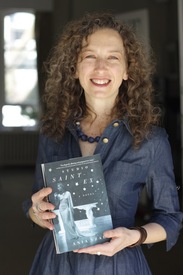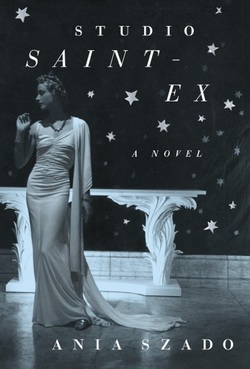 Ania Szado Ania SzadoPhoto by Katrina Afonso Ania Szado's acclaimed second novel, Studio Saint-Ex (Viking Canada/Knopf USA) has been sold to five countries. Her debut novel Beginning of Was (Penguin Canada) was regionally shortlisted for the Commonwealth Writers' Prize, Best First Book. Her short fiction has been published in numerous literary magazines and anthologized in All Sleek and Skimming (Orca, ed. Lisa Heggum). Ania's nonfiction has appeared in the Globe & Mail and Flare Magazine. She lives in Toronto and holds an MFA in Creative Writing from University of British Columbia and an AOCA from Ontario College of Art. Visit her website or follow her on Twitter: @AniaSzado. RUSTY TALK WITH ANIA SZADO Kathryn Mockler: What is your first memory of writing creatively? Ania Szado: I remember writing the copy for a "Best of the West" newspaper that covered the goings-on of the cowboy action figures that my brother and I played with when we were little... but my strongest early memory is less pleasant. I wrote a poem in the style of Dr. Seuss. It must have been pretty good. My teacher insisted that I had to have plagiarized it, though I hadn't. That soured me on writing for a while. KM: Why did you decide to become a writer? AS: I had been doing visual art, but I'd always wanted to write. It took me a while to get up the courage—I was a voracious reader and was pretty much in awe of writers; I didn't dare imagine I could be capable of being one myself. When I finally made the decision to swallow my insecurities and hone my writing skills, I found that I was more creative and committed as a writer than I was with paint. I found my direction and voice slowly, but right from the start, the work I was producing seemed to have more potential than anything I'd produced as a visual artist, and the act of writing was intensely satisfying. KM: What is the best piece of writing advice you’ve been given that you use? AS: It wasn't advice so much as a description of a way of working. I took a novel class with Catherine Bush when I was doing my MFA, and she mentioned that she sometimes leaves the manuscript, and just sits on the sofa with a notebook, asking and answering questions about the work-in-progress. That opened the door for me to adjust my own process along similar lines, and I think it has helped my writing immensely. KM: Can you describe your writing process? AS: The one thing that is consistent in my writing process is that I have to get away, now and then, to completely immerse myself in my work. I do writing retreats of between a week and a month. I'll write for minimum 15 hours a day; my longest stretch was 22 hours. Most days I don't step outside. I eat simple foods, the same thing every day. No radio or TV or music or news. I think of nothing but the story world; I don't even leave it when I'm asleep. I've done this for first drafts and I've done it for rewrites. I'm always anxious before I begin, but I set up immediately and start working right away, and then it's just the bliss of intense, satisfying work and creative intellectual challenge. When I'm not on retreat, I might write several hours a day or not at all—it depends on the stage I'm at in a novel and whether there are other pressing demands on my time. When I'm working, I shift between writing on the laptop and working things out in a notebook. KM: What is your favourite or funniest literary moment, if you have one? AS: What springs to mind is one of the coincidences that came up during the writing of Studio Saint-Ex. A character in the novel, Saint-Exupéry's real-life friend Bernard Lamotte, had his painting studio on East 52nd Street in NYC in the 1040s; there's a plaque on the building to commemorate Saint-Ex's working on The Little Prince there. I created a social club for the city's French expats, called it the Alliance Française, and placed it across the street from Lamotte's studio—in what is actually the Cartier building. Some time later, I queried a contact at today's Alliance Française about the history of the organization. She told me that the organization was itinerant in the early '40s; they borrowed space as they needed it. When she went into the files, she discovered that one of the buildings they used in the early '40s was actually the Cartier building. What's more, the modern-day Alliance had, until recently, owned a Lamotte mural. The woman told me she herself had been responsible for auctioning it off. She'd had no idea Lamotte and Saint-Exupéry had been friends. KM: Tell us about your new novel Studio Saint-Ex? AS: Studio Saint-Ex tells the story of Antoine de Saint-Exupéry writing The Little Prince in early 1940s Manhattan, through the eyes of two women vying to win his heart and save him from his inevitable fate while also grappling to achieve status and success of their own. One is a young fashion designer; the other is his fiery estranged wife. The Little Prince runs throughout the book as a symbol of passion, love and destruction. KM: How did you approach the research for this project? AS: I began by researching Antoine de Saint-Exupéry, first by reading one after another of his many biographies. I read or reread his novels and other writing, including his letters. I was most interested in his NYC years, when he was writing The Little Prince, and eventually I pieced together the other elements of the story I wanted to tell. That led to research on WWII New York, the beginnings of American haute couture, the French expat community in Manhattan, and numerous other side roads. I had a great resource in a Saint-Exupéry scholar who took me on tireless walking tours of Saint-Ex's NYC locales and sent me packages of useful material. I had the insights of my seamstress mother and designer sister to draw on to supplement my research into sewing, fabrics, and the fashion industry. All the while, I was writing, working out the story—and revising it as the research revealed new possibilities or roadblocks. KM: What are you working on now? AS: I'm in the early stages of exploring two very different ideas for the next novel. One involves two artists. The other has to do with a lost—and found—child.  ANIA SZADO'S RECENT NOVEL Studio Saint-Ex, Penguin Canada, 2013 Description from the Publisher: In the glittering world of Manhattan's French expats and 1942 Quebec, a twenty-two-year-old fashion designer on the cusp of launching her career is swept away by the charms of French writer and war pilot Antoine de Saint-Exupéry ... and enmeshed in the schemes of his beautiful, estranged Salvadoran wife, who is determined to win back her husband—at all costs and seductions. With Paris under occupation by Hitler's troops, New York's Mayor LaGuardia vows to turn his city into the new fashion capital of the world—and Mig Lachapelle leaves Montreal for New York to make her name. She finds herself pulled into a fiery romantic triangle in which ambitions, creativity, and passions catch a literary giant between two talented, mesmerizing women and imperil the fate of his work-in-progress, The Little Prince—a poignant tale of a young boy's loneliness and love among the stars, one of the best selling and most beloved novels of all time. Read an excerpt here. |
Rusty Talk
Rusty Talk Editor: Archives
November 2017
Categories
All
|

 RSS Feed
RSS Feed
